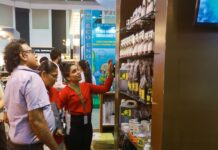By: Imesha Dissanayake
We often ask the question as to why Sri Lanka should decarbonise when our carbon emissions are relatively low. This is true as the country’s share of global carbon emissions is only 0.06% and has been plateauing at the same rate for the last five years since 2015. However, as an island nation, Sri Lanka is very vulnerable to climate change impacts and hence joining hands with global decarbonisation initiatives is imperative for the country. The global climate risk index 2021, ranked Sri Lanka as the 23rd most affected country from extreme weather conditions during the period of 2000–2019.
Therefore, Sri Lanka is susceptible to temperature rise, rainfall variability, and sea-level rise. A rise in sea level will hamper sectors of the economy such as tourism and fisheries. A significant population of the country is also dependent on livelihoods connected to agriculture and will be adversely affected due to impacts of climate change. The World Bank estimates that the country’s GDP could decline by 7.7% by 2050 in a worst-case scenario where no action is taken to combat climate change. This is estimated to result in a loss of USD 50 billion to the economy over the course of the period.
Sri Lanka also contains hidden hotspots that are often not discussed in public fora. Climate change poses an economic risk to these hotspots. The World Bank identifies hotspots as a location where changes in average temperature and precipitation will have a negative effect on living standards. The World Bank assessments show that approximately 19 million people in Sri Lanka are currently living in locations that could become moderate or severe hotspots by 2050 under a situation where no action is taken to limit emissions. This population is equivalent to about 90% of the country’s population.
Sri Lanka has a global responsibility to achieve climate change commitments as well, since, the country signed and ratified the Paris Climate Agreement. This resulted in Nationally Determined Contributions (NDCs) being developed initially in 2016 and renewed every 5 years in accordance with the 21st Conference of the Parties (CoP) commitments. Currently, the updated NDCs in 2021 accounts for 4% and 10.5% of unconditional and conditional actions, respectively, for reducing greenhouse gas (GHG) emissions against the Business-As-Usual (BAU) scenario during the period of 2021-2030.
It must be noted that in spite of abiding by these international climate commitments, it would still put the world on course for 2.7°C of warming this century while, net-zero pledges could reduce warming by 0.5°C. The UN Environment Programme (UNEP) reports that the new and updated global climate commitments only accounts for an additional 7.5% reduction of emissions while a 30% reduction is needed for 2°C and 55% is needed to meet the 1.5°C Paris goal.
Sri Lanka is also reliant on its export earnings and Foreign Direct Investments (FDI), and there are key business risks associated with lackluster attempts at decarbonisation. The rapid pace at which countries are moving towards becoming net-zero carbon economies is also determining the global demand for products and services. This has led to consumers and investors seeking products and services that underpin low carbon emissions. Hence, it will be crucial for the country to latch onto the shift in demand and reap benefits of having products and services that produces less carbon emissions.
Therefore, quick decisive and implementable actions are needed to decarbonise the country, since decarbonisation of an economy or a business takes a significant amount of time. As observed in other countries, climate change impacts disproportionately to the poorest and marginalised communities. This is more so applicable in Sri Lanka, as a majority of the population are living in rural areas and engaged in small-scale agricultural activities or fisheries activities that are increasingly threatened by extreme weather events and irregular monsoon rainfall patterns. This is in return can exacerbate poverty and inequality within regions of the country.
Sector Overview
Observing the carbon emissions by sectors in 2018, the transportation sector is the highest contributor of carbon emissions followed by electricity and heat sector. While carbon dioxide is the most dominant GHG produced by burning fossil fuels and industrial production, there are others that are driving global climate change. This includes methane, nitrous oxide, and trace gases, which have contributed to a noteworthy amount of global warming. A brief overview of sectors with high emissions, which are of economic importance to the country is given in the section below.
Transportation Sector
The transportation sector is grappling with many issues such as congestion, pollution and a resultant substantial fuel bill. The private and public transportation accounts for nearly 60% of the fuel consumption in the country. Congestion is particularly seen in city limits such as Colombo with about 1.9 million passengers entering the City of Colombo daily.
One of the causal factors for these issues has been the growing population of private vehicles in the absence of good public sector transportation modes. About 85% of the vehicle population in Sri Lanka are privately owned vehicles, namely; cars, motor bicycles and trishaws. The growing disposable income, urbanization, availability of credit, and the need for last mile transport can be identified as the reasons for this trend.
Energy Sector
Historically growth in electricity demand of the country has seen a direct correlation with the growth in the country’s Gross Domestic Product (GDP) and hence, plays a vital role in the economy. In this regard, the sector has seen high level interest from the top most officials in the country including HE president in achieving a 70% renewable energy target by 2030 as announced in the annual budget of 2020. However, the government is yet to gazette this target and make it part of the formal state policy.
The electricity generation for the last two years show that renewable energy accounts for approximately 35% of the total energy mix in 2019 and 2020. Coal and oil have contributed to more than 60% of total generation mix in the same period. The current power outages experienced by the country is a result of the energy sector’s dependence on fossil fuel for generation and lack of reforms in the sector.
Manufacturing Sector
The value added by Sri Lanka’s manufacturing sector as a percentage of GDP stood at 18% in 2021. Manufacturing sector exports such as Apparel is the largest contributor to the country’s export earnings with a share of 43% in 2021. Therefore, with a change in demand by consumers and investors for products that generate low carbon emissions, it will be imperative for the country’s manufacturing sector to adopt low carbon measures in order to attract investors for more local value addition and as well as to cater to a growing market.
The Apparel industry’s key customers in export destinations are increasing the pressure to decarbonise supply chains. Examples of these include Science Based Targets initiative (SBTi), G7 Fashion Pact and EU Carbon Border Adjustment Mechanism (CBAM), which are likely to include apparel, metal and ceramics with time.
Agricultural Sector
The agricultural sector plays a vital role in Lanka’s economy with linkages across all sectors. It contributes to key exports of Sri Lanka such as Tea and Rubber that accounted for 11% and 8% of the export earnings in 2021. The agriculture sector, accounts for 7% of the GDP and employs nearly 30% of the country’s labour force. About 70% of the rural population is dependent on livelihoods attached to Agriculture and utilizes 43% of the total land area of the country. Climate change impacts such as irregular rain patterns, and extreme shifts between droughts and rainfall, directly affects agricultural activities.
The agriculture sector in Sri Lanka as assessed by Climate Watch data is the highest contributor of both methane emissions and nitrous oxide emissions, albeit contributing to low emissions in carbon during 2018. Methane and nitrous oxide are mainly produced through agricultural activities such as rice production, and from the use of chemical and organic fertilisers.
Way Forward
- Introducing direct power purchase agreements together with power wheeling
Globally countries are offering power purchase agreement models that yields financial as well as environmental benefits to organisations. This allows companies to work with a renewable energy developer and receive renewable energy directly from the developer. Power wheeling will allow renewable energy developers to use existing transmission and distribution networks to supply renewable electricity to prospective buyers. An appropriate fee for the grid can be charged for this purpose.
- Roadmap for circular economy
The country lacks a road map for encouraging a circular economy in Sri Lanka. As a first step, identifying sectors that have linkages within other sectors can be explored, where output waste can be translated into input material of another sector. This is already taking place in the brewing industry and in the case of PET bottles. Coupling waste management and energy generation is another area for the circular economy that can also look beyond key urban areas.
- State-Owned Enterprise (SOE) reform
Reforming SOEs can not only result in productivity and efficiency gains but also facilitate innovations in the enterprises that will aid in carbon reduction mechanisms. It will also provide the entities with additional revenue to pursue the carbon neutral targets. Reforms can be carried out to entities such as Sri Lanka Transport Board and unbundling of the CEB. Partially listing a percentage of SOEs on the stock market would also help to increase public oversight and increase accountability for achieving carbon emission targets.
- Solarisation
Solarisation can take many forms including; highway solarisation; solarisation of railway and bus stations; and conversion of existing industrial zones to renewable energy industrial zones. Sufficient storage capacities will be required for this process with technologies such as pump hydro and battery storage that will facilitate high renewable energy integration to meet real time electricity demand. A significant amount of investments too is required for this and hence can be opened up for investors with conducive policy to support it.
- Electric vehicle policy
Sri Lanka lacks a policy for Electric Vehicles (EVs) with a proper mechanism of disposing batteries of EVs. Therefore, a policy on EVs together with a proper mechanism for disposing batteries will be imperative in reducing the fuel dependency of the country, which thereby can reduce forex outflows. Feasibility of local value addition for batteries can also be explored as about 70% of the value of EV’s are in the battery. Further, establishing more charging stations for EV and solarisation of EV charging stations will make EVs more sustainable.
- Public transport strategy
A public transport strategy covering both bus and railway sectors is imperative for the country. This will enable the public transport systems to be safe, affordable and attractive to the public. This can encourage the shift from private vehicles to public transportation modes, which in return can reduce congestion and pollution in the country. The strategy can encompass sector reforms; digitization; standards and quality assurance processes; and rationalised pricing regimes
- Introducing parking facilities
Introducing parking facilities at city entry points, especially in the Colombo city limits with shuttle bus services is another area that can aid in transferring passengers from private vehicles to public transportation, reducing congestion and pollution. The shuttle bus service can be operated with electric buses to support the initiatives of reducing fuel dependencies.
Conclusion
Climate change does not stop at borders, as with the on-going pandemic, and requires the same level of urgent and decisive measures to avert its detrimental impacts. The above-mentioned strategies can help the country to be placed on a path towards achieving carbon neutrality. This will result in improved growth and development, improved living standards, and help reduce poverty and inequality.
The economic crisis the country is currently experiencing, presents an opportunity for Sri Lanka to decarbonise. This can act as a catalyst to tap into green financing that can help in closing the gap between financing and infrastructure needs of the country while also improving the country’s foreign reserves. Hence, this is an opportune time for Sri Lanka to reduce its dependency on fossil fuel and reduce its strain on the import bill. This can bring in new avenues of FDI to the country and improved performance of export earnings. This can also ensure that sustainable projects are in place to build resilience for future crises.
The full report can be accessed at: Catalysing Decarbonisation in Sri Lanka
The writer is a Senior Research Associate attached to the Economic Intelligence Unit of the Ceylon Chamber of Commerce. This article is part of the Strategic Insight Series, which focuses on key contemporary topics.












